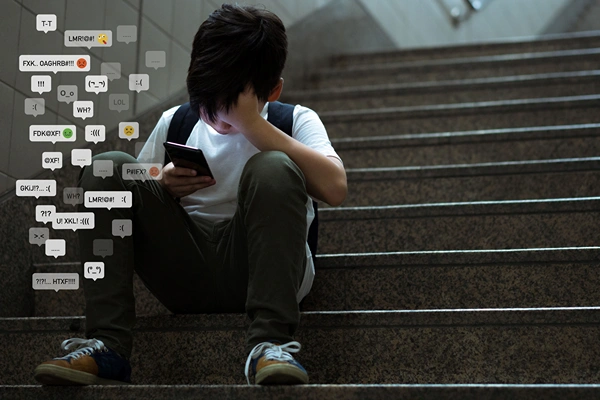Is Your Child Being Cyberbullied? Warning Signs & What to Do About It
Our children navigate a world far different from the one we knew growing up. While technology offers incredible opportunities, it also presents new challenges, one of the most concerning being cyberbullying. This form of bullying extends beyond the schoolyard, invading the very homes and minds of our children through their devices.
We aim to shed light on the insidious nature of cyberbullying, its warning signs, and, most importantly, practical steps you can take as a parent to protect and support your child. Let’s explore how we can empower our kids to navigate the digital landscape safely and build resilience against online threats.
What Is Cyberbullying?
Cyberbullying is when someone uses technology (smartphones, computers, or tablets) to embarrass, harass, or even threaten your child. Social media, online gaming platforms, school forums, and messaging apps are common sources where hateful comments and threats can spread like wildfire. In cyberbullying, there’s the anonymity factor, which means bullies hide behind fake profiles, making it hard to track them down.
Cyberbullying is worse than traditional bullying. Traditional bullying ends in school, giving your kids relief once they are home. Cyberbullying is terrible. It follows you everywhere. Unlike the days of schoolyard bullying, cyberbullying sticks around all day long, literally 24/7. Worse still, because these platforms are digital, harmful messages can spread quickly. It can be shared, reshared, saved, and sometimes live on indefinitely.
Warning Signs Your Child May Be Cyberbullied
In today’s digital age, cyberbullying has become a widespread threat to children and teens. As parents, we want our kids to enjoy the advantages of technology -connecting with friends, learning new things, and having fun. But sometimes, that same screen can become a source of pain. Cyberbullying is persistent and can be damaging. Knowing the signs early is important to protecting your child’s physical and mental well-being. Here are some warning signs of cyberbullying and the steps to take as parents to help your child through it.
Emotional & Behavioral Changes
If your child has gone from giggles and laughter to withdrawn, moody, and anxious, it might not be “just a phase”. It could be a digital distress signal. If you notice your kids bursting into tears after checking their phone, refusing to tell you anything about their day in school, or make negative statements like “Nobody likes me anymore” or “i hate my life”, chances are your kid is a victim of cyberbullying, and their digital life is messing with their real life.
Avoidance of Technology
If your child is being cyberbullied, they may avoid the very devices that are supposed to connect them. If your child once loved gaming or binging on social media but suddenly avoids their gaming devices or favorite social media platforms, there is a good chance your child is being cyberbullied.
If you notice that your child turns off their notifications, logs off social media after you walk into their room, hesitates to open their favorite app, or leaves their phone in another room, they may be trying to hide the fact that someone is targeting them online.
Academic & Social Impact
Ironically, when the online world turns toxic, it can spill into real life and your child’s school life. Cyberbullying can make your child dread going to school. They become afraid of the gossip and jokes targeting them. Similarly, doing homework becomes the last thing on their mind, especially if they are constantly replaying the cruel message in their head.
If you notice your child suddenly isolating themselves, reluctance to go to school accompanied by complaints of illnesses that clear up by noon, or slipping grades even in their best subjects, chances are they have become the target of cyberbullies.
Physical Symptoms
When your child is targeted online, their brains flood with cortisol, the stress hormone”. Over time, this can wear down their immune system, disrupt their digestion, and even rewire how they process pain.
Stress from cyberbullying can manifest in your child’s body, and sometimes kids don’t dare to tell you they are being bullied online. If you notice your child has trouble sleeping, lies awake for hours, is exhausted during the day from lack of night sleep, has frequent headaches, low energy, and unexplained stomach aches, these may all be tell-tale signs that your child is under significant stress from someone picking on them online.
Unexplained Financial Requests
Cyberbullies extort kids for profit. Some cyberbullies often demand payment in gift cards, cryptocurrencies, in-game credits, or even cash as blackmail to avoid sharing embarrassing or intimate content online of their victims. Because gift cards and the like are untraceable, they are a tool for online extortionists.
If your kid is suddenly making unexplained or urgent financial demands, cash disappearing from your wallet or savings jar, unexplained charges on your account, chances are they need the money to pay off or appease someone who’s trying to manipulate or bully them online.
Secrecy About Online Activity
Notice your kid acting super secretive when online or becoming overly protective of their devices? It’s time to pay closer attention. When kids are vulnerable, they might try to hide their online activities and may go as far as deleting their accounts without explanation.
While teens crave privacy, extreme secrecy about their online activity, such as deleted messages, hidden accounts, or sudden defensiveness, can be a sign that some are cyberbullying them. Sudden password change, creating ghost accounts, staying online late, deleted history, closing tabs when you approach, or device possessiveness are red flags that your kid is trying to hide their online activities because someone is targeting them online.
What to Do If Your Child Is Being Cyberbullied
You may feel overwhelmed or helpless if you discover that your precious one is caught up in the storm called cyberbullying. The good news is that there are practical steps you can take to help your kids navigate this challenging phase of their lives.
Step 1: Stay Calm & Open the Conversation
First of all, take a deep breath. It is only natural to feel upset or even angry when you learn your child is being targeted. However, it’s important to stay calm. Children can pick up on your stress. Keeping your cool creates a safe space for a heart-to-heart conversation with your child.
Find a quiet moment when you are both relaxed. Begin the conversation by reassuring your child that the bullying isn’t their fault. Instead of yes or no questions, try asking open-ended questions to get a clearer picture. Try questions like, “Can you tell me something that has been bothering you online?” Or “how did those messages make you feel?”. These types of questions show that you are genuinely interested and willing to listen and help your child understand that it’s okay to talk about their feelings. Let your child know it’s okay to feel upset, confused, or even angry. Reassure them that their feelings are valid. If they are not open to talking immediately, don’t pressurize them. Instead, let them know you’re ready to listen whenever they are ready to talk.
Step 2: Document and Report the Bullying
Documenting bullying can be to your advantage, especially in a digital world. Keep a record of what’s happening so you can fully understand the situation and take the necessary steps to address it.
Take screenshots when your child receives harmful messages, images, or posts. They will serve as evidence when you report the bullying. Most social media sites, gaming platforms, or messaging apps have reporting tools on the platform. Show your child these features and use them to report the behavior to the platform.
Should the bullying escalate to threats, harassment, or leaked personal information, report the behavior to the school authority or law enforcement immediately. If the person bullying your child online goes to the same school as your kid, let a teacher, counselor, or principal know about it. Most schools take cyberbullying seriously and have policies and protocols in place to address the issue.
Contact your local law enforcement if the cyberbullying degenerates into threats of violence, stalking behaviour, or the sharing of personal images. You can file a police report. If you are unsure where to start, many schools have a School Resource Officer (SRO) who can point you in the right direction.
While reporting may feel intimidating, remember that you are taking the necessary steps to keep your child safe.
Step 3: Block & Limit Contact with the Bully
Help your child regain control. Most apps have a “block” option. You can use the privacy settings on the app to block or mute the bully. Better still, go through these settings on the app with your child and teach them how to use the block setting. You can use RAINN’s Social Media Safety page to guide you on blocking and reporting unwanted contact or content.
Sometimes, it may be tempting to answer the bully. However, encourage your child not to answer the bully. Explain that most bullies crave attention, and engaging the bully can only make things worse. By limiting contact with the bully, you can keep a bad situation from getting out of control.
Step 4: Strengthen Online Safety Measures
Staying one step ahead is important in keeping your child safe in today’s constantly changing digital world. Start by doing a deep dive into every app and social account your kid uses. Most platforms let you hide personal details like your location and switch to a private profile so only approved friends can see posts.
Encourage your child to only accept connections from people they know. Strangers could be bullies. Periodically review their friend lists together and remove anyone unfamiliar. Show them how to mute or restrict accounts that make them feel uncomfortable.
Talk to your child about their digital footprint—everything they post, like, or comment on leaves a trail online, which can affect how others see and interact with them.
Use parental controls wisely. Filter out inappropriate content, set screen-time limits or “bedtime” for devices, and monitor your child’s usage patterns without invading their privacy by reading their messages. Educate your child on smart online behaviour. Teach them to think before posting or replying, and how and when to use the report and blocking options if someone crosses the line.
Step 5: Seek Emotional Support
Cyberbullying can negatively affect your child’s self-esteem and mental health. Encourage your child to talk to a school counselor, therapist, or trusted adult. Having someone to talk to can make a difference. By seeking professional help, your child can get the guidance that even parents with the best intentions may not be able to provide.
Boost your child’s confidence. The Centers for Disease Control and Prevention’s Youth Risk Behaviour Survey notes that physical activity is a protective factor that can positively affect self-esteem, relationships, and academic achievement. Therefore, encourage your child to take on activities and hobbies that make them feel good about themselves. From sports and arts to just hanging out with a trusted friend, these positive experiences can rebuild your child’s self-esteem.
Let your child know you’re always there if they need to talk. Encourage regular check-ins. You can also encourage your child to join a support group where they can meet other kids who understand what they’re going through.
Preventing Future Cyberbullying
Whether chatting with friends, playing games, sharing pictures, or learning new things, your kids are online more than ever. As parents, you can prevent future cyberbullying by empowering your kids with the tools to handle themselves in the digital world.
- Teach Digital Resilience: Teaching your kids digital resilience is like equipping them with digital “armor” against hurtful comments and negative interactions. Discuss and teach them how to recognize and ignore or block mean posts and hurtful comments. Encourage your child to take screen breaks when things get overwhelming. Build their inner confidence that cyberbullies cannot shake and remind your child about their talents and good qualities.
- Encourage Open Communication: There’s nothing an open, honest conversation cannot fix. Assure your kids that no matter what they see or experience online, you’re always ready to listen without judgment or blame. Create a safe space at home where your child can feel comfortable talking to you about their digital adventures.
- Set Screen Time and Social Media Guidelines: Create family rules about how and when devices should be used. Set limits for screen time. Establishing clear guidelines about device usage can help keep your kids safe online and develop a healthy relationship with technology.
- Model Good Digital Behaviour: Kids are great copy-cats. They learn by watching us. If you want your child to be kind and respectful online, lead by example. Show your kids how to engage respectfully online, even when faced with negativity.
Final Thoughts
Cyberbullying is a very real issue, but it is totally manageable with the right approach and supportive resources. As parents, it is important to remember that while the digital world comes with its share of risks, it also offers incredible opportunities for connection, creativity, and learning for your kids. Therefore, you need to help them strike a healthy balance.
Good communication goes a long way. Let your child know that they can talk to you about anything they see online without judgment. Don’t focus on over-monitoring your kids online. Instead, focus on building trust.
Set up clear, responsible guidelines for screen time and social media use. You may want to create these rules together with your child, so they feel involved in the process, rather than making them feel like you are imposing strict rules. One of the most important things to remember is that you are your kids’ role model. When your child sees you managing your digital life respectfully, they are likely to follow your good habits.
Remember, dealing with cyberbullying is serious, but with the right approach and resources, you can navigate this murky situation, bringing your child to a balanced and safe digital life.
For additional support, consider using resources like StopBullying.gov, a U.S. government resource offering detailed guidance on addressing and preventing cyberbullying. Parents in need of guidance and support can call the National Parent Helpline at 1-855-427-2376. They offer advice on a range of parenting challenges, including how to handle cyberbullying.
Ben Hartwig

Ben Hartwig is a web operations director at InfoTracer.com. He authors guides on marketing and cybersecurity posture and enjoys sharing best practices.









